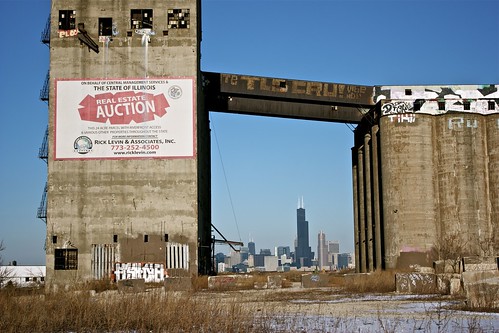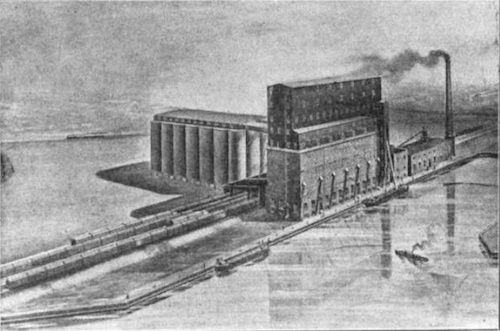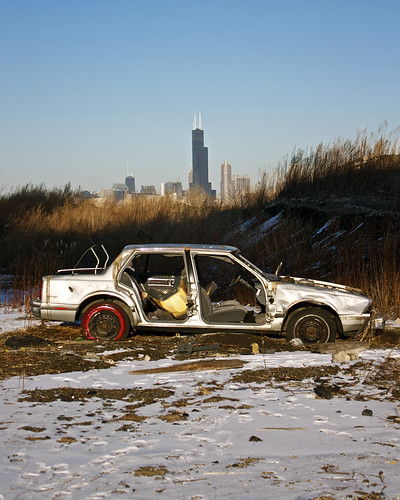Photo: The state of Illinois would like to move this property that sits opposite downtown Chicago.
The colloquial “Damen Silos” harken back to an era when Chicago was a big player in the grain trade. The land on which the grain elevator lords over has been in use since the early 1800’s. In 1832 a fire broke out at the grain elevator and then rebuilt with with concrete. Disaster struck again on September 9, 1905 when spontaneous combustion killed several workers and consumed the entire building within an hour. Immediately thereafter architect John S. Metcalf was commissioned to build the current elevator.
Photo (source): View of the grain elevator looking northeast.
The National Park Service has an entry describing the location.:
The John S. Metcalf Company, consulting engineers, designed and built this facility for the Atchison, Topeka & Santa Fe Railroad in 1906. The original complex included a powerhouse, elevator with temporary storage and processing silos, and thirty-five grain storage silos. With a 400,000 bushel capacity, this complex could accommodate sixty railroad cars at the elevator and 300 railroad cars at a yard a short distance away. Equipmentat the site included two driers, bleachers, oat clippers, cleaners, scourers and dust packers. Using filtered water from the adjacent South Branch of the Chicago River, boilers with a total of 1,500 horsepower generated the steam and electricity required bythemachinery. The thirty-five grain silos south of this facility had a total capacity of one million bushels. In 1932, a grain dust explosion ignited a fire which destroyed the original timber and brick building. The Atchison Topeka & Santa Fe Railroad rebuilt the concrete processing house with fourteen reinforced concrete silos; the capacity of the facility was increased to 1,700,000 bushels. After reconstruction, the rail road leased the facility to the Stratton Grain Company.
Photo: (source): Drawing of the grain elevator from around 1908.
In 1977 another large explosion caused significant damage to the grain elevator. Afterwards the location fell into disuse and became property of the state. The real estate company charged with selling the property states “the property was owned by the state who wanted seventeen million for it and it didn’t sell. They have lowered it to eleven million, but they are only willing to sell it in one big chunk.” In this economic downturn it is highly unlikely that this waterfront property will move anytime soon.
Photo: A lone abandoned Oldsmobile Eighty-Eight hides below the view of the Chicago skyline.
The silos were the last location of the day during this urbex expedition. The sun was fast fading and we were a bit fatigued. Other urbex explorers have braved several stories of rickety stairs with missing platforms to get shots from the top of the cavernous silos. I wasn’t having any of that. I had already broken my tripod handle and slipped on some ice. My urbex partner lost a lens cap and broke his tripod leg. We were content with just standing in awe of the colossal monument to human industry.
Resources:
Flickr – My Abandoned Damen Silos set.
Flickr – Search for most interesting photos tagged “damen+silos.”
GenDisasters – Excerpt from New York Daily Tribune about 1905 fire.
Google Books – 1908 description of the grain elevator.
Historic American Engineering Record – Description of location and photo inventory for the Library of Congress.
John Hutton (PDF) – Thesis proposal for redeveloping the site.
Library of Congress – 19 b&w photos of the grain elevator.
New City – A brief history and quotes about the silos.




I recently visited this site this past weekend. I was there with two fellow photographers. While there we ran into 3 more. We decided to climb the rickety stairs that lead to the top of the silos. The bottom four landings are missing but you can still balance yourself and reach the top. I had driven by these for many years…and i was finally able to explore them.
It’s always cool when you run into other urbexers. I don’t have the stomach for climbing the silos though. I’m pretty clumsy.
The amount of machinery that is located at the top…and over the 35 silos is amazing, you could easily spend hours here…this was the third location that we visited so we were pretty tired. Standing right over the silos gives you a sense of vertigo. There were people that braved the single rusted out ladder that lead down into the silo…evidence by the graffiti that could be seen at the bottom of some.
I came around on the Canalport Riverwalk path from the Ashland Ave bridge, across the inlet to the east, and that was close enough for me. Here are some pictures:
Damen silos from the east
Pretty cool and daring that you guys climbed up there!
Some really nice and utilitarian information on this site, too I believe the style and design holds fantastic features.
I have to let you know that vehicle was a film prop, and not an abandoned vehicle. I was part of a film crew that placed it there for a short. It’s no longer there. The pictures are still wonderful though!
Very cool. Thanks for the update!
The Damen Silos – Exploring America's Gritty History I was recommended this website by my cousin. I am not sure whether this post is written by him as no one else know such detailed about my trouble. You are amazing! Thanks! your article about The Damen Silos – Exploring America's Gritty HistoryBest Regards Nick
A pretty interesting documentary about a guy who’s living at these silos:
https://vimeo.com/41527049
I was recently informed that a set of stairs that lead up to the top floor of the silos has been removed. This renders the upper area unreachable. Can anyone confirm this? Is there any other way to reach the top from the inside? If the removal of the stairs turns out to be true, than this is a major bummer!
There is a way, but I’ve tried it and it’s very dangerous, but worth it. Someone placed a rope on the stairs that led up to he top. It’s behide the building, near the water. If you go there, you’ll likely see it. But be careful!
there are ladders inside the silos straight up about ten stories very scary but worth it once you get to the top…….or make a rope ladder and connect to the fire escape and take the fire escape up to the top and the stairs were removed a while ago
to get to the ladder you have to find the entrance to get under the buliding itself and make sure yu have a flashlight!
They gong to implode them today for the next “Transformers” movie.
[…] the failed candy factory attempt, we made our way to our final location of the day, the Damen Silos, another location that Transformers 4 will be shooting at, as we seen some spaceships on the […]
There ain’t no bridge anyone! Transformers 4 done blown it up!
[…] ‘Game Art Tricks’ series / the work of artist Terence Tenison Cuneo / the Damen Silos, Chicago, also seen in this elegant drone eye view / Exploring Abandoned Mines / all the Death […]
I love the Damen silos. Insanely easy to get in. There are a few entrances. I usually take the river walk and hop up onto a wooden plank by the water. The people you meet are awesome, you should talk to them and plan to go to other abandon sites, always good to have a group of passionate explorers :). I’ve been up the ladder in the smaller silos once and it was terrifying, go one at a time because one side of the ladder near the top isn’t screwed into the wall. I’ve been up the fire escape stairs 4 times already, amazing climb, gives u one hell of a rush the first time but pretty calming the second time around. The top of the largest building has the best view of the city ( pictures on my instagram – @pesc_e). Trespassing isn’t that big of an issue here because it’s an in a very open area next to an express way and some kind of yacht club bullshit on the river. Oh and if you’re doing the largest rope up to the smaller fire escape, do it with gloves, fucked my hands up going down. The basement of the silos is extremely dark, bring flashlights. Have fun
I was involved in rehabbing the silos in the mid 80s for fly ash storage, hence the reason for the unloading piece of equipment jutting out of one silo, we removed all the grain equipment in the basement , be glad to discuss further